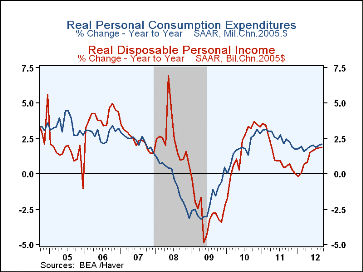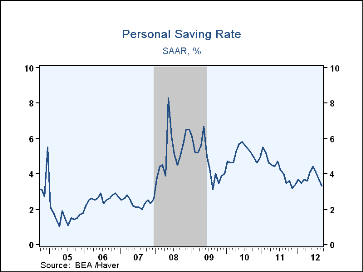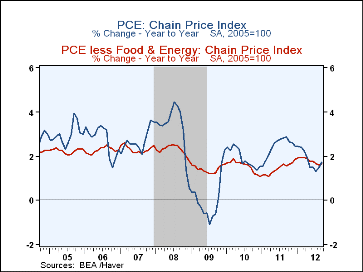 Global| Oct 29 2012
Global| Oct 29 2012U.S. Prices Eat Away Income Gain
by:Tom Moeller
|in:Economy in Brief
Summary
Disposable personal income grew 0.4% during September, the most in six months and a pickup from the negligible 0.1% August uptick. However, adjusted for price inflation, disposable personal income slipped marginally (+1.9% y/y) after [...]
 Disposable personal income grew 0.4% during
September, the most in six months and a pickup from the negligible 0.1%
August uptick. However, adjusted for price inflation, disposable
personal income slipped marginally (+1.9% y/y) after an unrevised 0.3%
August decline. That dropped three-month growth in take-home pay to
-0.8% (AR), its weakest in twelve months. In nominal terms, overall
personal income rose 0.4% (3.9% y/y), about as expected, fueled by an
improved 0.3% (3.9% y/y) gain in wages & salaries. Proprietors income
rose a hefty 1.1% (4.8% y/y) but interest income was down 1.2% (-1.6% y/y)
for the third straight month. Transfer payments rose a moderate 0.5% (3.3%
y/y).
Disposable personal income grew 0.4% during
September, the most in six months and a pickup from the negligible 0.1%
August uptick. However, adjusted for price inflation, disposable
personal income slipped marginally (+1.9% y/y) after an unrevised 0.3%
August decline. That dropped three-month growth in take-home pay to
-0.8% (AR), its weakest in twelve months. In nominal terms, overall
personal income rose 0.4% (3.9% y/y), about as expected, fueled by an
improved 0.3% (3.9% y/y) gain in wages & salaries. Proprietors income
rose a hefty 1.1% (4.8% y/y) but interest income was down 1.2% (-1.6% y/y)
for the third straight month. Transfer payments rose a moderate 0.5% (3.3%
y/y).
Despite the recent decline in real income, consumers kept spending. The dollar value of personal consumption expenditures jumped 0.8% (3.8% y/y) last month, the largest increase in eighteen months. A 0.6% rise was anticipated. Nominal spending on durable goods jumped 1.1% (6.5% y/y), bolstered by a 1.4% (8.4% y/y) gain in spending on motor vehicles. Nondurables spending surged 1.7% (4.3% y/y). However, that increase reflected a 5.4% (7.1% y/y) surge in gasoline purchases. When adjusted for inflation, spending on gasoline fell 1.3% (+0.5% y/y). Overall, real personal spending grew 0.4% (2.1% y/y) last month. Spending on motor vehicles rose 1.5% (8.1% y/y) and spending on appliances & furniture jumped 1.4% (6.5% y/y).
The moderate gain in income, set against a firm rise in spending, reduced the personal savings rate to 3.3% last month, its lowest since November of last year.
The PCE chain price index advanced another 0.4% (1.7% y/y). Nondurables prices jumped another 1.2% (2.4% y/y) with the rise in gasoline prices. Durable goods prices slipped 0.2% (-1.6% y/y) while services prices increased 0.2% (2.0% y/y). Less food and energy, the PCE chain price index ticked up 0.1% (1.7% y/y) as it has for six months this year.
The personal income & consumption figures are available in Haver's USECON and USNA databases. The consensus expectations figures are in the AS1REPNA database.
| Personal Income & Outlays(%) | Sep | Aug | Jul | Y/Y | 2011 | 2010 | 2009 |
|---|---|---|---|---|---|---|---|
| Personal Income | 0.4 | 0.1 | 0.2 | 3.9 | 5.1 | 3.8 | -4.8 |
| Wages & Salaries | 0.3 | 0.1 | 0.2 | 3.9 | 4.0 | 2.1 | -4.3 |
| Disposable Personal Income | 0.4 | 0.1 | 0.2 | 3.6 | 3.8 | 3.8 | -2.7 |
| Personal Consumption Expenditures | 0.8 | 0.5 | 0.4 | 3.8 | 5.0 | 3.8 | -1.9 |
| Personal Saving Rate | 3.3 | 3.7 | 4.1 | 3.5 (Sep'11) |
14.2 | 5.1 | 4.7 |
| PCE Chain Price Index | 0.4 | 0.4 | 0.0 | 1.7 | 2.4 | 1.9 | 0.1 |
| Less Food & Energy | 0.1 | 0.1 | 0.1 | 1.7 | 1.4 | 1.5 | 1.4 |
| Real Disposable Income | -0.0 | -0.3 | 0.1 | 1.9 | 1.3 | 1.8 | -2.8 |
| Real Personal Consumption Expenditures |
0.4 | 0.1 | 0.3 | 2.1 | 2.5 | 1.8 | -1.9 |
Tom Moeller
AuthorMore in Author Profile »Prior to joining Haver Analytics in 2000, Mr. Moeller worked as the Economist at Chancellor Capital Management from 1985 to 1999. There, he developed comprehensive economic forecasts and interpreted economic data for equity and fixed income portfolio managers. Also at Chancellor, Mr. Moeller worked as an equity analyst and was responsible for researching and rating companies in the economically sensitive automobile and housing industries for investment in Chancellor’s equity portfolio. Prior to joining Chancellor, Mr. Moeller was an Economist at Citibank from 1979 to 1984. He also analyzed pricing behavior in the metals industry for the Council on Wage and Price Stability in Washington, D.C. In 1999, Mr. Moeller received the award for most accurate forecast from the Forecasters' Club of New York. From 1990 to 1992 he was President of the New York Association for Business Economists. Mr. Moeller earned an M.B.A. in Finance from Fordham University, where he graduated in 1987. He holds a Bachelor of Arts in Economics from George Washington University.








